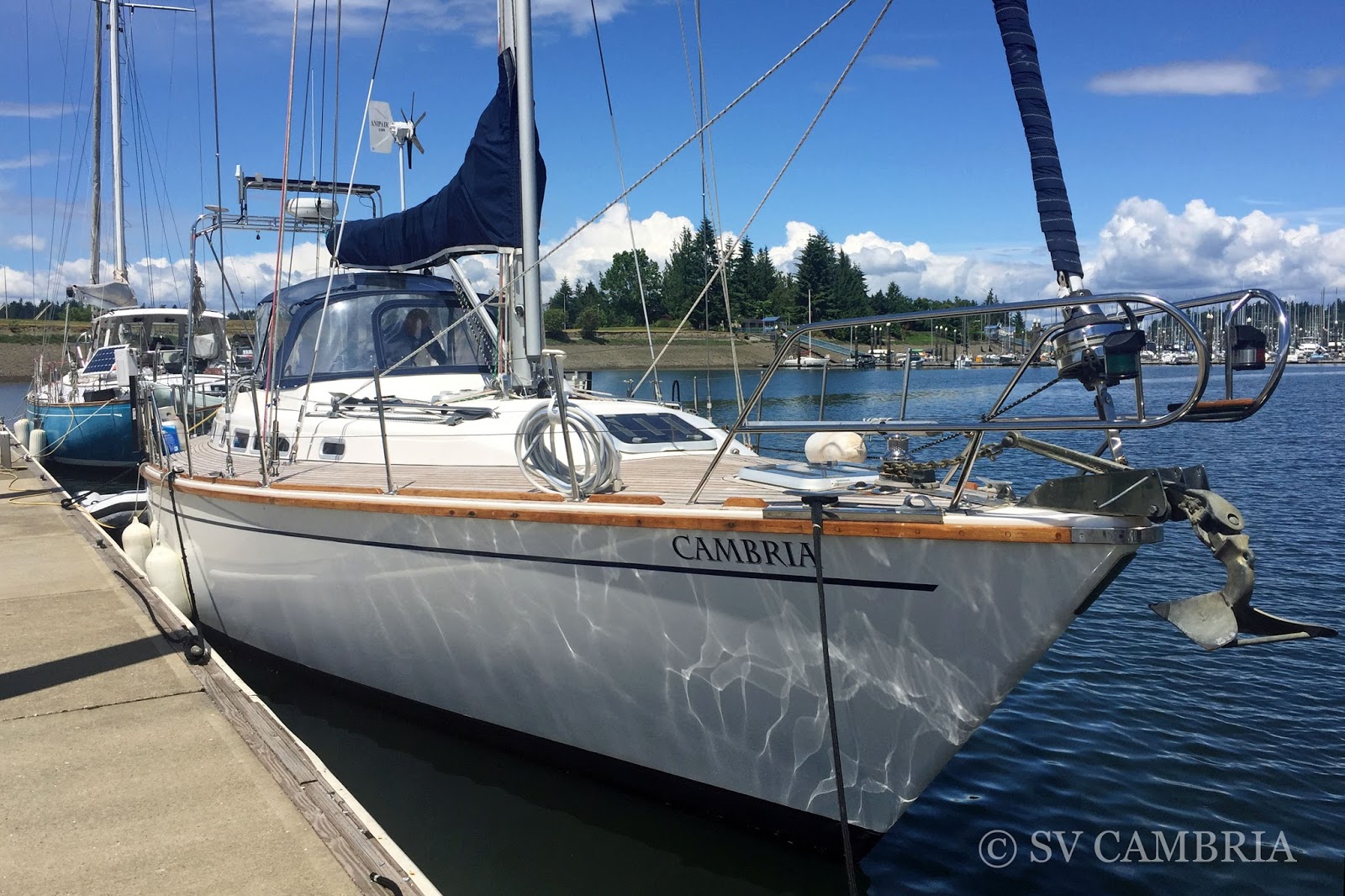We’re in between “homes” right now, sitting at anchor in a little village north of Kingston trying to decide our next move. WiFi is hit and miss and the signal through the cellphone isn’t much better – three bars of “edge” coverage. So, it’s taken some time to update the blog with the second part of our recent stay in the hardstand (you can read the first part here). Here’s how I left things:
Over Memorial Day Weekend, we were approaching Tacoma Narrows when our prop snagged a plastic bag that was hidden below the surface. The following week, we scheduled an emergency haulout in Swantown Boatworks where David checked the prop and the shaft for damage. Everything checked out okay and Cambria was dropped back in the water on Thursday. David engaged the engine while the Travelift waited on standby in case there was a problem: We had rear propulsion back and the ticking sound that was coming from the prop was gone, so we tied up to the work dock for the night with plans to leave the following morning with the tide.
Encore, Encore!
Did you know props can sing? They can. Not very well, mind you. Some props just do it (something to do with propeller diameter, rpm, boat speed, trailing-edge size and “roundness” of the blade and includes complicated math that I have no interest in exploring). But ours never has. Not until that Friday.
We untied our lines and started to make our way up Bud Inlet. Everything was fine until we cleared the marina. We upped the throttle and started to hear a strange noise a few minutes later. It sounded like a work whistle from adjacent lumberyard; but it persisted. I stuck my head outside the cockpit for a better “look” and the sound faded. It wasn’t them, after all. It was us: We would have to come out of the water again.
We turned around and slowly made our way back to the work dock. A little research and a few phone calls later and we learned the prop was most likely out of balance – something that wasn’t apparent until we reached a high enough speed and had enough water flowing past it. It would have to be sent to the shop for service, a process that could take two or three weeks.
The boatyard was busy and couldn’t schedule us to haulout until Monday, so we stayed put for the weekend. We were joined by Mike and Melissa from Little Cunning Plan who had completed their time in the hardstand – the lucky buggers. We didn’t get to socialize much, though. As luck would have it, we both had family coming into town.
David got a call from his eldest son, John, Friday night. On a whim, he and his husband, Craig, decided to cash in some air miles and fly up to Seattle for the weekend. So we rented a car on Saturday and joined them for drinks at a local brewery. We had such a great time! So good, in fact, that we didn’t get back to Olympia until two in the morning and had to call security to let us in the boatyard. Needless to say, Sunday was a day of rest as we waited to start the process all over again.
Monday afternoon arrived and we were on the hard once more, using the day to remove the prop and shaft again. This time David brought the shaft over to a local shop and had it bench tested, and it was 70/1000 out of alignment (our shaft has a 30 mm diameter). The damage had been hiding at the point where the shaft tapers down to meet the prop.
Back to Seattle
Another day and another rental car later, we brought the shaft and prop to Seattle. The news wasn’t good. The bend on the shaft couldn’t be straightened and a new one would have to be made. Surprisingly, it only took one day and the company, Sound Propeller Services, delivered it to us in Olympia on Wednesday where it sat for another week or so waiting for its mate, MaxProp, to arrive.
For those of you with a MaxProp in the Seattle area, there are two places to have your prop serviced – PYI and the other is the PropShop, Ltd (as opposed to the three other Prop Shops in town). Word to the wise – don’t bring your prop to PYI. They’re more expensive, take longer, and don’t actually do the work themselves – they send it to the PropShop, Ltd. So you might as well cut out the middle man and save a little time and money.
From then on, all we could do was wait. I’d polished the hull the week before and had done the anti-fouling on our last haul-out (which was only seven months ago). Olympia’s a pretty nice little city, but there’s not a lot to do outside of visiting the restaurants, cafés, and bars – none of which appeals to us. We could have taken a tour of the Capitol building, but somehow forgot all about that distraction – probably too busy feeling sorry for ourselves.
It was more than a week later when we learned what was wrong with the prop: Three of the internal gears had been damaged – all from a ridiculous plastic bag. In hindsight, it makes sense. The amount of torque applied was enough to make us believe we’d hit a log. And when David ran the numbers, he came up with an applied force ranging somewhere between 950 and 1,000 pounds: We should’ve known better than to think we’d gotten away (relatively) scot-free.
Our insurance company’s marine surveyor said we needed to replace the cutlass bearing (something we’d just done in October), which David organized through Aloft Marine in Swantown. The shaft is 30mm but the stern leg is an inch and three-quarters – a metric and imperial mix. They do make cutlass bearings like that, but they apparently take a long time to come in. The closest we could get on short notice was a 30 x 45 mm bearing which then had to be set on a lathe to turn the outside diameter down to 1 ¾ inches. With the old bearing pressed out and the new one in place, David could install the new shaft.
We took painful measures to make sure the shaft was clean – one little burr or piece of dirt could catch on the dripless stern gland seal and damage it – and carefully slid it into place only to discover it wouldn’t marry up with the transmission coupling. So, out it came. David used a piece of 800-grit wet sandpaper to polish the end of the shaft and we tried again. Success . . . sort of.
The engine was slightly out of alignment. We scratched our heads a bit and, in the end, decided the new cutlass bearing was the most likely culprit. I won’t bore you with the details other than to say that accessing all four engine mounts to make the adjustments is a job better suited to a small child than an adult male and David came out of it battered, bruised, and dripping with blood. But he finished the job and all we had to do then was wait for the prop arrive.
Sound Propeller Services, the company that made our shaft, offered to deliver our MaxProp from the Prop Shop, Ltd, so we were saved the trouble of renting another car and dealing with the Seattle traffic. It arrived late on a Friday, which meant we couldn’t get back in the water until Monday (as a standby). We’d already been out of the water for three weeks so what’s a couple more days, right? Wrong.
It's a Heat Wave
The weather had been heating up over the course of the week and we were struggling to keep the boat cool (and by “cool” I mean under 90°F), so our goal was to get back in the water before the weekend when the local forecast was calling for 93°F on Saturday and 97°F on Sunday. It wasn’t meant to be.
We had a backup plan – renting a hotel room for a couple of days. But there was a job to be done and David was determined to do it. It wasn’t easy. The prop had to be reassembled in place and there wasn’t much for shade near the stern of the boat. The best he could do was work a little, take a break in the shade, wipe away the sweat, and get back to it.
If you’ve never seen a MaxProp disassembled, it’s a lot like one of those wooden puzzle cubes – every piece fits together in a specific way. First comes the hub, which is secured to the shaft. Next is the spinner, the gears and, finally, the blades. If any one of the pieces isn’t put back together perfectly, the whole thing is wrong (the pitch being the most obvious problem but we know of a situation where the prop ran in reverse when the transmission was in forward). It’s a complex little machine. Clever. But complex, nonetheless.
The MaxProp had been restored to factory original and, the clearances were very tight, so David had to hand-fit it as well. That meant taking it all apart, easing the clearances by lightly sanding the surfaces, and putting it all back together. And that was that. The job was done.
We’d survived the yard and the heat wave. The boat was ready and so were we. Now all we needed was Monday to roll around and for somebody to cancel so we could get back in the water. As luck would have it, someone did. And this time when we left Olympia, no siren called us back to its shores – we were free to go anywhere we chose. So we did.















3 comments
Wow! What a saga. And the metric and imperial mix- give me a break!
ReplyDeleteWe've had temps in the high 90s with heat indexes up to 110. It means we can only work outside in the early morning and late at night. We spent $900 just on replacing the sail cars that cracked during my 3AM crash gybe. It's taken me a full month just to think about facing the ocean again. Even though I'm really bummed you had to have such a long ordeal, it makes me feel a little better.....it's not just us and our boat, it seems like things going wrong are a fact of cruising life, It seems wrong to complain since we are living the life we chose...but sometimes boats and boat life really do get depressing.
We have an 11 yr old niece and we often lament not having her on full-time to get into spaces and climb the mast, etc. We've just never been able to convince her (and her parents, lol).
As long as the positives outweigh the negatives, right? Once that balance changes... it is time for something else! To be honest, I am surprised we lasted eight years.
DeleteWhat an ordeal... So much work, so much patience, so much sweat. I am so glad that it is all behind you both!! We know first hand how hot and humid a summer on the hard (in Maryland, Panama and Grenada) and in the dessert (Arizona) can be. I didn't think I would ever utter these words as a Belgian, but: "Hurray for air conditioning"!
ReplyDelete